|
The
Removal of Engraving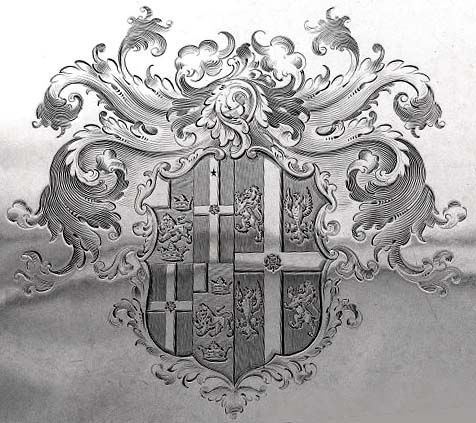
A hand engraved monogram or any
type of decorative engraving is part an object's history and unique
to that piece. Removing engraving does not always make a piece more
salable, especially if the engraving is of high quality –
quality seldom seen today with the declining number of outstanding engravers.
Some tips for collectors and
antique dealers debating whether or not to have engraving removed:
(1.) If it is a tray or hollow piece, rub your fingernail under or
inside to determine if the metal is thick enough to have the
engraving removed. If you see a slight wave develop as you move your
fingernail, the piece is probably too thin.
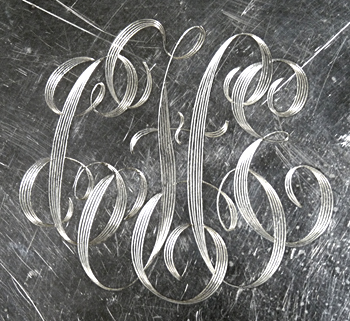 Remember,
if the engraving is removed you run the risk of caving in that area
with very little pressure. Can you imagine setting a coffee pot
on a footed salver and having it sink into the center? (2.) If you
have never used a repair service, test the reliability of the
silversmith with a small piece of damaged flatware first. A competent
smith will do a great job or suggest that the repair not be attempted
at all. (3.) If engraving is removed from a hollow form or tray and
you would like it reengraved, have it done in a different area where
the material is thicker. An engraved area, especially on a thin
piece, will be rather weak. Remember,
if the engraving is removed you run the risk of caving in that area
with very little pressure. Can you imagine setting a coffee pot
on a footed salver and having it sink into the center? (2.) If you
have never used a repair service, test the reliability of the
silversmith with a small piece of damaged flatware first. A competent
smith will do a great job or suggest that the repair not be attempted
at all. (3.) If engraving is removed from a hollow form or tray and
you would like it reengraved, have it done in a different area where
the material is thicker. An engraved area, especially on a thin
piece, will be rather weak.
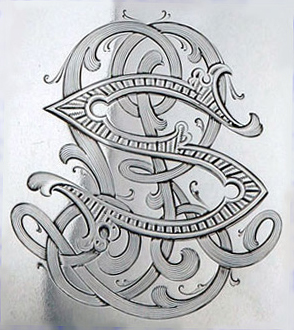
If you must have engraving
removed, take the piece to a competent smith, otherwise it may be
ruined and the piece devalued. Engraving that has been expertly
removed will be undetectable on the surface. Upon removal of deep
engraving, on a coffee pot for example, the metal may have to be
pushed out from the inside to develop a level surface.
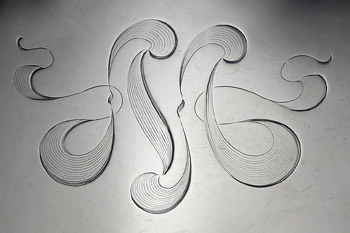
Candlestick/Candelabra
Thread Repair
Over the years, weighted
candlestick and candelabra threaded inserts can become worn, allowing
them to continue rotating in the corresponding sockets without
properly “catching.” Redefining these threads properly can
be quite costly, since the pitch that is used as a reinforcing cement
must be removed before pushing out the threads from inside with
special tools.
In most cases, you can repair the
insert threads yourself, allowing them to fully engage the
corresponding socket threads. Go to your local hardware store or
furnace and duct supplier and ask for aluminum tape. This is aluminum
foil with an extremely sticky backing. Take the section with the worn
threads and cut a piece of aluminum tape the same width as the
threaded section. Remove the backing and wrap the aluminum around the
threaded insert and cut it as close as possible to meet with the
other edge. It’s better to be a little undersize than have to
overlap the seam.. Next, use finger pressure to massage the foil
securely onto the insert. Finish the job by using your fingernail to
trace the threads around the circumference of the insert, making them
more distinct.
Gently screw the insert into the
socket, testing how it “sits” without wobbling. If there is
still substantial play in the socket, allowing the insert to continue
spinning, wrap it with another layer of tape as described above.
Disposal
Damaged Flatware
Has a piece of your flatware ever
slipped down the garbage disposal? If so, you may have gone into
shock in regard to its mangling. The spoon bowl may have been
crushed, fork tines wrapped around each other, the handle folded in
half or even chopped into many pieces. A monogram may also have been
gouged. That piece of flatware, with the possible exception of hollow
handled knives, need not be taken to the refiner; it most likely can
be repaired to a functional state!
In order to correct the shape and
finish of the piece during its repair, it is recommended to send a
perfect duplicate piece for matching. Flatware that is highly
ornamental, especially on the handles, may not be economical to
restore. In this case you may wish to simply have any sharp or jagged
edges smoothed to make the piece useful once again.
If you feel the piece doesn't
warrant the repair expense, it can most likely be replaced through a
silver replacement service. Since many patterns over time have been
produced in different weights, it is best send a sample to the
service to be matched.
The
Realities of Weighted Sterling
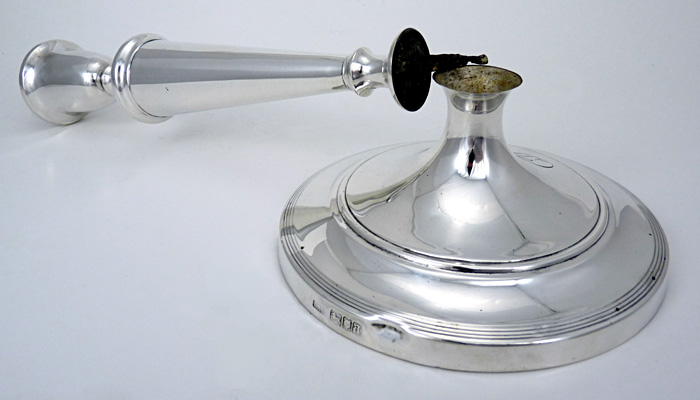
The article below discusses
weighted sterling that is reinforced throughout the entire object.
These are pieces that would not be functional if the silver alone was
their only support.
You just forced a candle into one
of the candle cups of a weighted, two-arm candelabra. What you didn't
expect to experience was the arm being ripped from its stem. Have you
ever polished a candlestick and wondered what that rattling noise
was? I know all too well what that sound is: its cement (most
commonly pitch, which is made from various percentages of pine resin
and plaster) had reduced in volume when it was first poured, then
cooled inside the object, creating a void. This allowed pieces of
this brittle material to break off and rattle inside that space.
Weighted sterling may also contain, lead, wax, sand, or some other
material for support. Since the sterling is very thin (I've measured
metal thickness as thin as .003"), there is then not enough
support for that area of your object to withstand a dent when lightly
tapped against a hard surface. You'll also find pitch inside most
dresser brushes and hand mirrors that probably show signs of denting
from even the most cautious user. You may have seen a dresser brush
with very deep embossing, revealing a cherub with a hole in its nose.
At that very point, the material may have been only .002" thick
when it came out of the factory. Sliding the brush over a dressing
table a few times and heavy-handed polishing may have been all it
took to go through that nose. If these pieces were not weighted, they
would almost collapse! If you are the victim of one of these pieces,
I know your frustration.
What you may not be aware of is
that although your candelabra may weigh a hefty four pounds (64
ounces), in reality it contains only about 6.4 ounces (5.83 troy
ounces) of sterling! Simplified, this means your candelabra is
composed of 10% sterling and 90% pitch. So, if you wanted to scrap
that candelabra using a $10 silver market, the refiner would pay you
no more than $48. Something else to keep in mind: many refiners will
also charge a refining fee of $50 or more. You just lost two dollars!
Stunned? You're not alone.
Welcome to the sad reality of
weighted sterling. When the silver companies first introduced objects
that were made of this paper-thin sterling, they intended on making
utilitarian holloware and dresserware that was more affordable to the
mass-market. Though you may have thought you were purchasing a
quality piece of silver, it later turned out to be nothing but
aggravation in its use and cleaning.
Also, this thin material is not
easily repaired. In fact, most restoration services will not work on
weighted sterling. If you have a piece in need of repair, please e-mail
detailed images of it for an estimate.
Candles and weighted sterling
Over the years I have repaired
numerous weighted candlesticks and candelabras. Many of these repairs
involved reattaching the tops of candle cups. The reason they become
detached is because the candles are allowed to burn all the way down
to the bottoms of the holders. The heat from the burning wick melts
the pitch that fills the body of the cup and expands, pushing up the
cup's top.
Handling weighted sterling
1. Do not display in a window
where the sun will soften the pitch, possibly making the object or
appendage droop.
2. Keep away from fireplaces and ovens.
3. Of course you would never put
a weighted piece (or ANY sterling) in the dishwasher.
4. Always support a candelabra
arm underneath when inserting a candle.
5. Never overtighten threaded
candelabra arms or candlestick components.
6. Gently polish and support the
piece when working on delicate areas.
7. Use only tepid water when
rinsing polish from the object.
8. Never expose dresser brushes,
hand mirrors, or related objects to liquids.
9. Do not soak weighted pieces as
there may be voids in hollow areas that will fill with liquid.
10. Dresser brushes, hand
mirrors, and related objects should always be gently placed on a
cotton or flannel cloth on your dressing table to avoid unnecessary wear.
11. If you hear rattling, be
particularly cautious in that area because it is not reinforced inside.
12. NEVER try to bend a weighted
object back into shape as this will most definately make the problem worse.
13. Always feel free to contact
me should you have any problems or questions.
Silver
With Loose and Deteriorated Components
Over time, insulators, handles,
finials, inserts, and other porous components of tea- and coffeepots,
sauce pans, wine bottle coasters, hairbrushes, and the like can
become loose and/or cracked. This may be the result of natural
shrinkage, aggressive handling, or running water over the component
and allowing moisture to enter the socket or ferule that holds it in
place, causing rot that can't be seen. These susceptible materials
include: wood, ivory, baleen, rhino horn, mother-of-pearl, and
tortoise shell, among others.
Unstable objects that are used on
a daily basis will only become more unstable over time. This can lead
to crumbling insulators, a broken-off handle, or a warped coaster
bottom, with additional damage occurring to the object's body. Here
are some suggestions:
1. Always support a teapot or
coffeepot from the bottom when holding it by the handle.
2. If a handle or brush is loose,
have it secured by a reputable silver restoration specialist. Have
broken or rotted components stabilized or replaced;
3. Never allow water to come
into contact with porous components;
4. Remove dried polish with a
cotton ball, Q-Tip, or soft brush;
5. With a lint-free cloth, apply
three coats of a high-quality, crystal-clear carnauba paste wax which
will protect against moisture and deterioration. This wax will also
prevent silver polish from accumulating in wood pores;
6. It is safe to clean or polish
an object if: (a) components are securely held in place and there are
no gaps through which moisture can seep into hollow areas and (b) wax
has been applied to the components. (Hairbrushes, nail buffers, and
combs should be cleaned only with non-abrasive, unscented, aloe-free
hand sanitizer, or with silver polish that is allowed to dry, and is
then buffed off);
7. Periodically re-wax porous components;
8. Consult me
should you have any questions. |

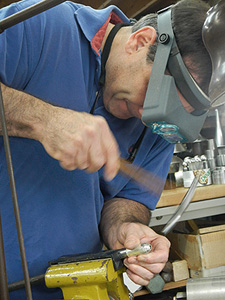
 Jeffrey
Herman disclaims any responsibility or liability for damages or
injuries as a result of any construction, design, use, manufacture,
restoration & conservation advice, or other activity undertaken
as a result of the use or application of information contained on
this website.
Jeffrey
Herman disclaims any responsibility or liability for damages or
injuries as a result of any construction, design, use, manufacture,
restoration & conservation advice, or other activity undertaken
as a result of the use or application of information contained on
this website.
 Remember,
if the engraving is removed you run the risk of caving in that area
with very little pressure. Can you imagine setting a coffee pot
on a footed salver and having it sink into the center? (2.) If you
have never used a repair service, test the reliability of the
silversmith with a small piece of damaged flatware first. A competent
smith will do a great job or suggest that the repair not be attempted
at all. (3.) If engraving is removed from a hollow form or tray and
you would like it reengraved, have it done in a different area where
the material is thicker. An engraved area, especially on a thin
piece, will be rather weak.
Remember,
if the engraving is removed you run the risk of caving in that area
with very little pressure. Can you imagine setting a coffee pot
on a footed salver and having it sink into the center? (2.) If you
have never used a repair service, test the reliability of the
silversmith with a small piece of damaged flatware first. A competent
smith will do a great job or suggest that the repair not be attempted
at all. (3.) If engraving is removed from a hollow form or tray and
you would like it reengraved, have it done in a different area where
the material is thicker. An engraved area, especially on a thin
piece, will be rather weak.


